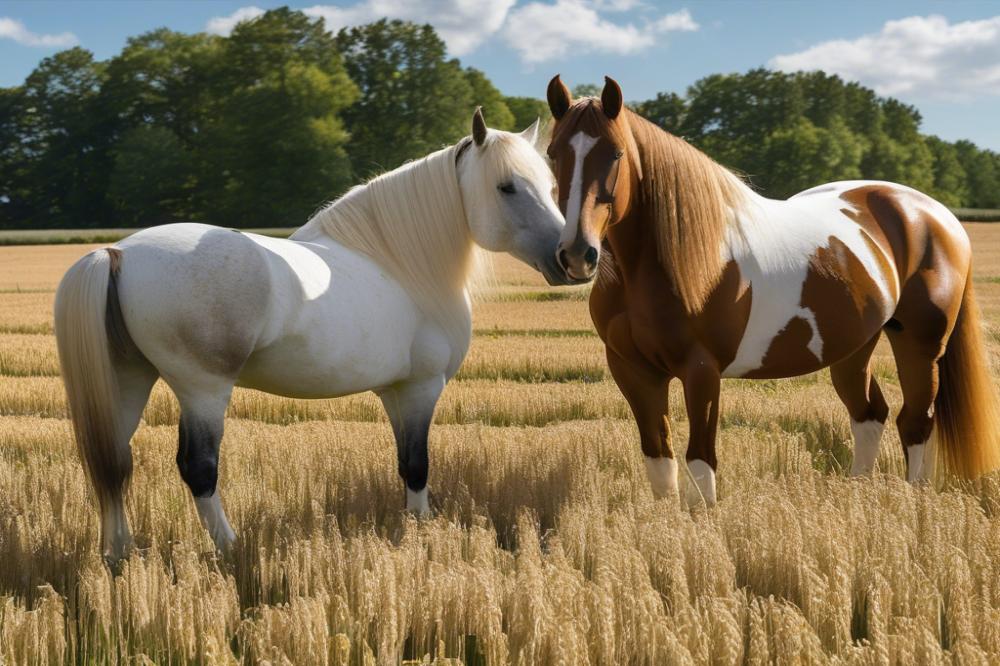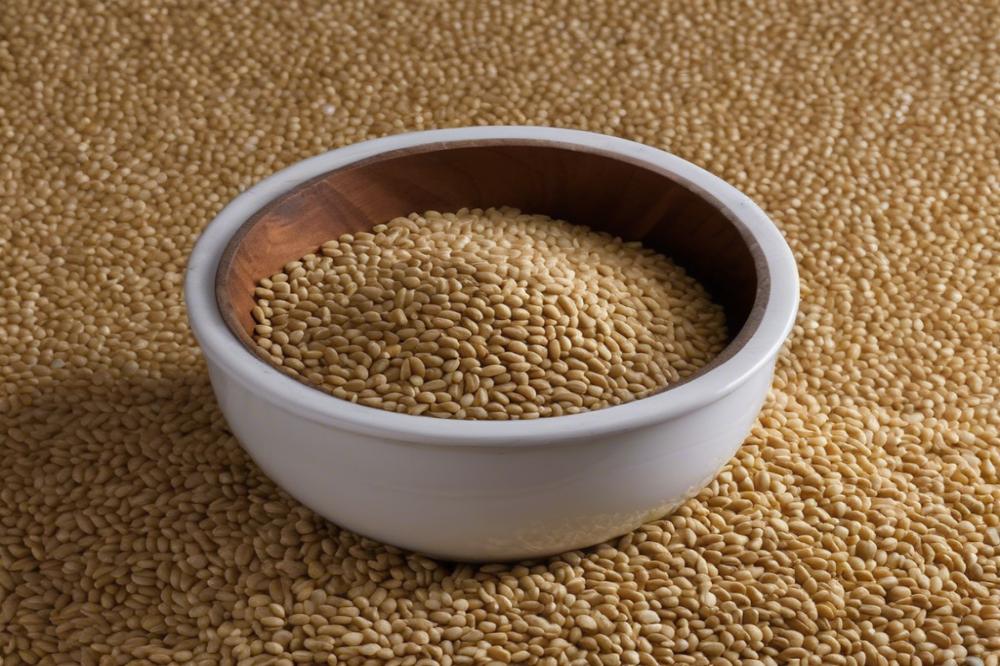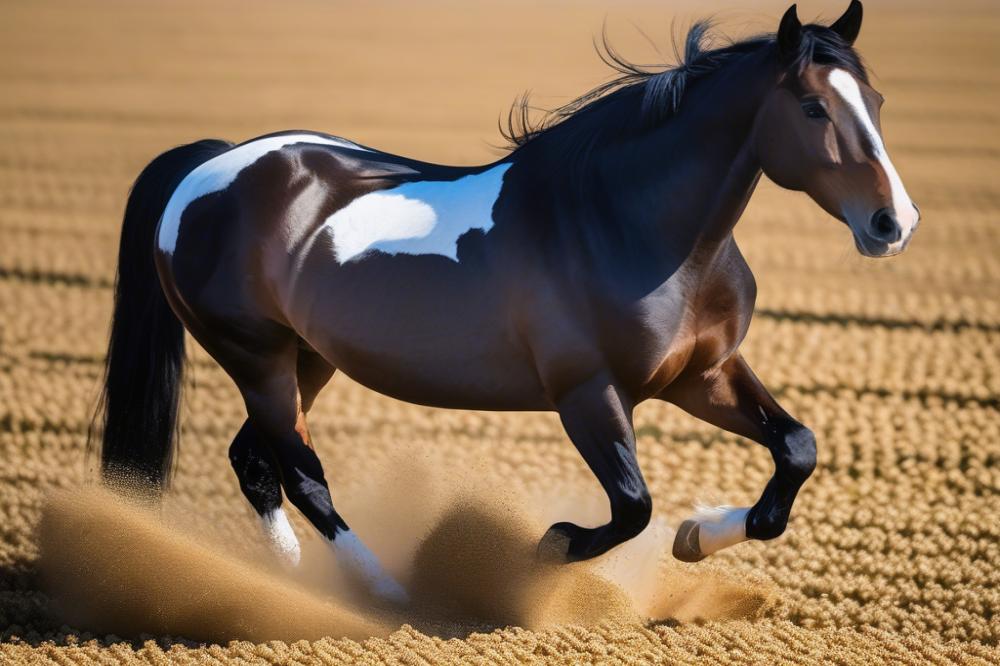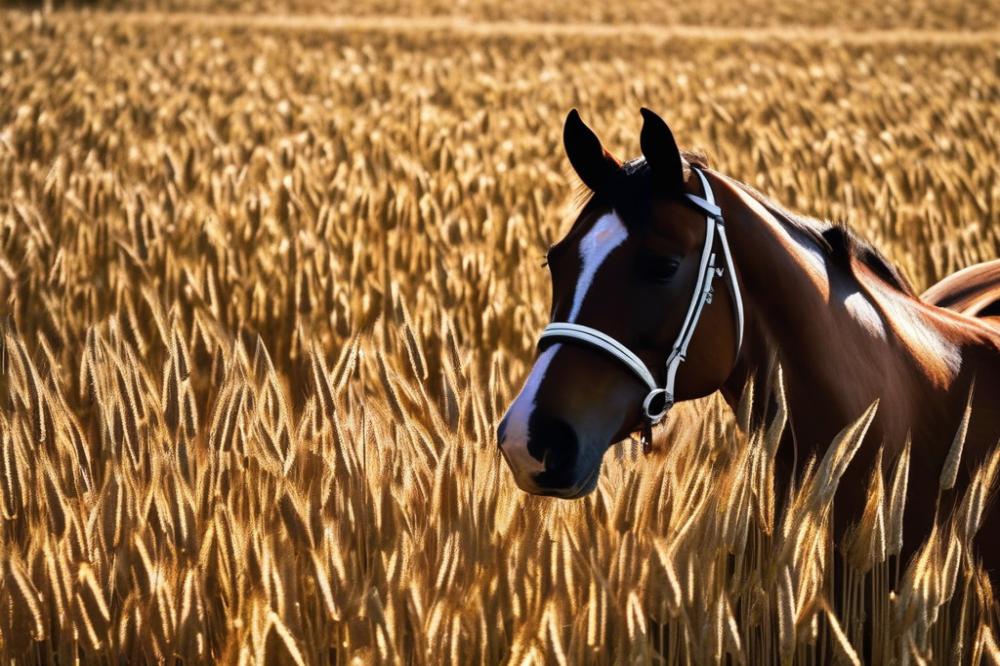Overview of Barley as a Feed Ingredient
When it comes to shaping the perfect horse diet, barley stands out as a reliable cornerstone of equine nutrition. This golden grain is not just a staple in many barns but is also packed with nutrients beneficial for our four-legged friends. It provides a rich source of energy, helping keep spirits high and hooves moving. Farmers and horse caretakers often swear by it, full of tales about how it keeps their steeds feeling lively and happy.
Importance of Understanding Horse Nutrition

Understanding horse feeding is crucial, whether you’re a seasoned expert or a novice. Horses are not just machines to ride; they are complex beings with specific dietary needs. Incorrect feeding can lead to various health issues that no one wants to deal with—imagine the chaos if your horse suddenly decided to become a couch potato! Knowledge is power, especially when dealing with the delicate balance of nutrients that our equine companions require. After all, a well-fed horse can perform splendidly, while a poorly-fed one might seem more like a medieval horse name pulled from a dusty old book, rather than the majestic creature they truly are.
Purpose of the Article

In this article, we’re diving deep into the barley benefits and how this grain can enhance your horse’s nutrition regime. We’ll explore why it holds a special place in a variety of breeds of horses list and how it fits into the broader scope of horse care. By understanding the role barley plays in horse feeding, owners can make informed decisions that contribute to their horse’s overall health and happiness. With so much information available, it’s easy to get lost, but we’re here to guide you through the barley wonderland of equine feeding. Grab a cup of coffee, settle in, and let’s unlock the secrets of barley for your beloved companion!
Nutritional Profile of Barley

Macronutrients in Barley
Barley packs quite a nutritional punch. It’s a fantastic source of carbohydrates, which are essential for providing energy to horses. When considering horse feeding, the carbohydrate content in barley helps fuel those beautiful runs and gallops across the field. Protein also plays an important role. While not as rich in protein as oats, barley offers a nice balance, promoting muscle development in our equine friends.
Fat content in barley is relatively low, so it’s not a heavy option. However, when included as part of a balanced equine diet, it can aid in maintaining a horse’s body condition. This is particularly vital for active horses that require stamina over bursts of speed. Including barley in their meals means horse owners can feel good about what they’re offering.
Vitamins and Minerals Present
Barley doesn’t just stop at macronutrients. You’ll find plenty of vitamins and minerals lurking within. It contains B vitamins, which are crucial for energy metabolism. Mineral content is decent too. Mineral levels, like magnesium and phosphorus, help with overall health and bone strength. With a strong mineral foundation, a horse’s performance can really shine.
Let’s not forget fiber! Barley has a fair amount of soluble fiber, which helps with digestive health. A horse with good digestion is a happy horse, and a happy horse keeps their human smiling too. Together, these nutrients contribute to proper horse care.
Digestibility and Energy Content
When it comes to digestibility, barley holds up quite nicely. Horses can break it down and absorb its nutrients effectively. That means your horse gets the most out of their meals, which is a big win. The energy content is also outstanding. Barley boasts a nice balance of readily available energy, ideal for the active horse.
The grain holds its own against other grains in terms of energy density. This makes it a wonderful choice to support a horse’s performance without overwhelming their digestive system. Ideal for athletic horses, barley benefits those needing sustained energy throughout the day. Including it in a horse diet can help keep energy levels stable, preventing those dreaded spikes and crashes.
Each element of barley brings a lot to the table. Knowing what’s in this grain can help horse owners make informed choices when it comes to feeding. It really is a versatile option that fits a variety of equine nutrition needs. Who would have thought that something as simple as barley could do so much?
Benefits of Barley in Horse Feed
High Fiber Content and Digestive Health
Barley brings a lot to the table when it comes to fiber. This grain helps to keep a horse’s digestive system running smoothly. With plenty of fiber, horses can munch away happily while avoiding some common digestive issues. Think of it as nature’s way of keeping the pipes clean! A healthy gut means fewer problems, which is something every horse owner appreciates. When considering an equine diet, fiber-rich foods are essential. They play a vital role in gut health and overall well-being.
Energy Source for Performance Horses
When it comes to horses that work hard, energy is crucial. Barley is packed with starch, making it a fantastic energy source. Whether it’s racing, jumping, or any other sport, performance horses need fuel. A diet that includes barley can help keep their energy levels up. Owners report that their horses feel vibrant and ready to tackle the day! Imagine a horse ready to sprint just because it’s got the right nutrition. It’s all about balance in horse feeding, and barley fits right in.
Role in Weight Management and Muscle Building
Managing a horse’s weight can be tricky. Luckily, barley can lend a hand. This grain provides nutrients without adding unwanted pounds too quickly. It aids in building muscle, especially in horses that need to gain strength and show condition. In the equine world, a strong body is often the key to success. To help gain the perfect shape, feeding just the right amount is essential. Barley benefits not just muscle development but also helps in maintaining a healthy weight.
Adding barley to your horse diet can make a noticeable difference. After all, every horse wants to feel great and perform well. So, why not consider this ancient grain for your equestrian needs?
Types of Barley Used in Horse Feed
Whole Barley vs Processed Barley
Whole barley is often the first choice for many horse owners, but what does that really mean? It simply refers to the grain in its natural form. Some folks might think it’s just like eating your veggies raw—great for some but not so easy on the stomach. Processed barley, on the other hand, includes options like rolled or cracked barley, which can be easier for horses to digest. If your horse isn’t a fan of chewing a lot, they may benefit from the convenience of processed grains.
Raw barley can pack a punch when it comes to nutrition. It’s loaded with fiber, vitamins, and minerals, making it a healthy addition to any equine diet. Processed forms can still hold onto many of these barley benefits, so don’t count them out! That said, you might want to check with a vet or an equine nutritionist before switching things up. It’s always wise to tailor the feed based on your horse’s needs.
Rolled Barley and Its Advantages
Let’s dive into rolled barley. Why should it get a starring role in horse feeding discussions? For starters, this grain is flattened during the processing, which helps it break down easier. Think of it like rolling out playdough; it changes the texture and makes it work better. Horses digest rolled barley more efficiently than whole grains, leading to better energy levels.
Another plus is that rolled barley can be mixed with other grains and supplements. This means you have more freedom to customize your horse’s meal! As an added bonus, some horses find rolled grains tastier than their whole counterparts. If you’ve got a picky eater on your hands, this might do the trick.
Barley Sprout Benefits and Usage
Now, let’s not forget about barley sprouts! They may sound like something you’d only find in a trendy health store, but they can be a fun addition to a horse’s feed. Sprouts are packed with nutrients like proteins, enzymes, and vitamins. This means they have a power boost that can help with digestion and overall health. Imagine trying to eat a plain potato versus a loaded baked potato; the toppings make all the difference!
Adding sprouts to your horse’s diet can be as simple as mixing them into their feed. Some people even grow their own for a fresh treat. It’s an exciting way to offer variety without breaking the bank. Plus, who wouldn’t want to spoil their equine friend a little?
Incorporating barley in a horse’s diet—whether whole, rolled, or sprouted—provides many options for horse care and feeding. Each type brings its own set of advantages; it’s all about finding what works right for your four-legged pal. Just remember, happy horses equal happy owners!
How to Incorporate Barley in Horse Feed
Feeding Guidelines and Amounts
Starting with the right amount is key. A good rule of thumb is to introduce barley gradually into your horse’s meals. This might mean adding just a handful during the first few days. Over a week or so, you can increase that amount, keeping an eye on how your horse responds. Typically, a horse can have around 2-4 pounds of barley per day, depending on their size and activity level. Always remember that individual needs can vary, so it is smart to consult with an equine nutritionist if you’re unsure.
Mixing with Other Feed Components
Barley doesn’t need to stand alone. It’s often best to mix it with other grains or a good quality forage. Doing so can balance out the nutrients and flavor. For example, combining it with oats or bran can enhance the palatability, making it more enticing. Plus, adding some fresh hay or chaff can help with digestion while providing fiber. Make sure to steer clear of sudden changes to their diet; horses thrive on consistency. You might think of it like tossing a pizza into the oven; add those toppings right and you’ve got a winner!
Monitoring Horse Response to Barley
Watching your horse after introducing barley is essential. Look for changes in energy levels and overall coat condition. If your horse buzzes with energy during rides, that’s a good sign! However, if their manure becomes too loose or they seem off, it might be time to adjust the amount. Remember, every horse is like a snowflake—unique in their dietary needs and reactions. Keeping a feeding journal can help track how your horse responds over time. Having a laugh about their antics can also lighten the mood while you monitor their progress! It’s all part of horse care and creating a happy equine diet.
Potential Concerns and Considerations
Allergies and Intolerances in Horses
Horses can be a bit like people when it comes to food allergies. Some may show signs of discomfort after eating certain grains. Barley could be on that list for a few sensitive equines. Watch for itching or unusual digestive behavior. If your horse seems off after munching on barley, it might be time to consult the vet. Keeping a close eye on how your horse reacts can help you make better choices for their equine diet.
Risk of Overfeeding and Digestive Issues
Overfeeding can lead to more than just a round belly. Horses may develop colic or other digestive troubles if they get too much of the good stuff. Balancing barley benefits with other feed types is crucial. You want to avoid turning your horse into a grain machine! Moderation is key here. Using a scale can help measure portions, ensuring your horse’s diet remains healthy.
Barley Quality and Sourcing
Not all barley is created equal. Quality varies widely depending on where it comes from. Buying from a trusted supplier can save a lot of trouble down the road. Look out for signs of spoilage or mold, which can sneak in unnoticed. Your horse deserves only the best in horse care, and that includes what’s in their feed. Remember, good sourcing can make a huge difference in your horse’s health. Choose wisely!
Alternatives to Barley in Horse Feed
Comparison with Oats and Other Grains
Oats are probably the most well-known substitute for barley. They provide a good source of energy and are easier to digest. Horses often enjoy their taste, which makes feeding time more pleasant. Rice bran is another option. It offers high fat content, which is useful for weight gain. On the other hand, corn can be considered as well. It is high in calories but can lead to issues if fed excessively.
Comparing these grains is like selecting different toppings for a pizza. Each has its own flavor and benefits. Oats tend to be better for horses needing more bulk without lots of energy. If your horse gets antsy or hyper, reducing the oats and considering flaxseed could be a wise move. Flaxseed is packed with omega-3 fatty acids. It’s like a secret weapon for coat health!
When to Choose an Alternative
Sometimes a horse needs a little variety in its equine diet. If you notice your horse getting bored with feeds, a switch might be just what you need. In cases of allergies or sensitivities, alternatives can provide much-needed relief. It’s crucial to keep an eye out for signs of discomfort. Just like you wouldn’t want to eat the same meal every day, neither would your horse.
Also, think about the specific activity level of your horse. Performance horses often require different nutrition than retired ones. If your equine friend is working hard, energy-dense grains may be essential. But, if your horse is more laid-back, lighter grains can work wonders. Balance is key in horse feeding.
Special Dietary Needs and Considerations
Every horse is unique, much like people. Some might need more fiber, while others have different weight goals. If you have an easy keeper, oats or alfalfa hay may do the trick. Avoid too many sugary grains; they can cause trouble. Many owners overlook weight management when selecting their horse’s food.
Horses with conditions like metabolic syndrome or Cushings require special care. Consulting a vet for professional advice is always a smart play. They can offer tailored recommendations based on your horse’s lifestyle. It’s important to be proactive in equine nutrition.
Keeping your horse’s health in mind will make a big difference. You wouldn’t skimp on good food for your family; treat your horse with the same respect. Mixing and matching different grains can lead to better overall health. Just remember, variety can not only spice things up, but also support optimal performance in your wonderful steed.
Wrapping It Up
Barley plays a significant role in horse nutrition, and understanding its benefits can be quite enlightening. Providing energy and essential nutrients, it’s often considered a valuable addition to many feeding programs. Horses thrive when given the right balance of ingredients, and barley fits into that picture smoothly. However, every horse is distinctly different, much like comparing a draft horse vs quarter horse. What works for one may not suit another at all!
It’s crucial to consult with a veterinarian or an equine nutritionist before making any changes to a horse’s diet. These professionals have the know-how to tailor feeding plans based on a horse’s individual needs. Think of them as your horse’s personal trainers who can suggest the best “diet” for them. Just like you wouldn’t trust a random online article for your fitness routine, don’t rely solely on general assumptions for your horse’s feed.
Paying attention to your horse’s specific condition, age, and activity level is important. Perhaps you have a show horse prepping for a horse halter show, or maybe a retired buddy who enjoys leisurely strolls. Both require different nutrition strategies. It’s like serving cake to a hungry crowd at a party versus a quiet dinner for health-conscious friends. The key is to evaluate their unique needs and adjust accordingly.
In essence, barley can be a wonderful part of your horse’s diet, but making an informed choice is essential. By staying mindful of your horse’s individual circumstances and consulting with the right experts, you can ensure that your equine partner thrives and stays healthy. After all, every horse deserves the best! So, don’t hesitate—dive into this journey of understanding and providing what’s truly best for your four-legged pal.



